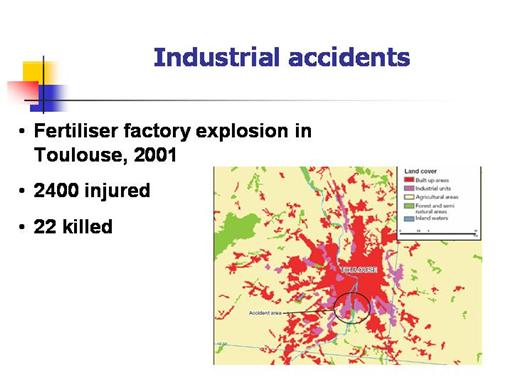| front |1 |2 |3 |4 |5 |6 |7 |8 |9 |10 |11 |12 |13 |14 |15 |16 |17 |18 |19 |20 |21 |22 |23 |24 |25 |26 |27 |28 |29 |30 |31 |32 |33 |34 |review |
 |
Fires or explosions account
for half of all industrial accidents recorded in Europe over the past
two decades. They are also the most dangerous type of industrial
accident. The worst industrial accident between 1998 and 2002 was the
explosion at an ammonium nitrate fertiliser plant in the French city of
Toulouse in September 2001. However, the heaviest toll in human lives
over the period was taken by accidents at fireworks
facilities. The most serious
of these was in May 2000, when 100 tonnes of fireworks exploded at a
warehouse in the middle of a low-income neighbourhood in the Dutch town
of Enschede. The blast killed more than 20 people, destroyed 500 houses
and left 2 000 people homeless. The same month five people were killed
and 18 injured in a fire and explosion at a fireworks factory in
Rafelcofer in Spain. In August 2001, an explosion at a fireworks plant
in Caldelas, Portugal, killed five people and injured another.
The geographical and temporal
impact of accidents involving fires and explosions alone tends to be
relatively limited but can be greatly magnified if, in a ‘domino
effect’, they result in toxic substances being released to air, water or
soil, as happened in the Toulouse disaster.
|